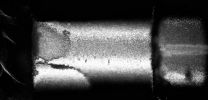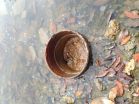Researchers at the University of Pennsylvania have now shown an important commonality that seems to extend through the range of glassy materials. They have demonstrated that the scaling between a glassy material's stiffness and strength remains unchanged, implying a constant critical strain that these materials can withstand before catastrophic failure, despite the extreme variation found among this class of material's physical properties.
This constant critical strain provides insight into the fundamental "seed" out of which failure in glasses grow: a small group of the glass's constituent particles or atoms that change shape in a collective way. Despite the disorder that epitomizes glass, this coordinated activity appears to be universal among many glassy systems, such as certain metals, polymers and colloids, and is an important starting point for designing more durable materials.
The study was conducted by graduate student Daniel Strickland and assistant professor Daniel Gianola of the Department of Materials Science and Engineering in Penn's School of Engineering and Applied Science, along with then graduate student Yun-Ru Huang and associate professor Daeyeon Lee of Engineering's Department of Chemical and Biomolecular Engineering.
VIDEO: Applying stress to their micropillars, the researchers found the point where fundamental event that leads to shear-banding becomes very favorable. They demonstrated that this point is roughly the same in...
Click here for more information.
It was published in the Proceedings of the National Academy of Sciences.
Glasses are amorphous, meaning that their constituent particles, whether they are atoms, colloids or grains, are arranged in a way that has no overarching pattern. The lack of internal consistency makes their behavior tricky to predict, especially when it comes to how they break or fall apart. Crystalline materials, which have atoms neatly lined up in repeating patterns, tend to fail starting at defects, or places where the pattern is disrupted.
The periodicity of these patterns also allows researchers to visualize the atomic structure of crystalline materials. No such ability is available for their glassy counterparts.
"There are lots of ways to map out the position of atoms and defects in a crystal," Gianola said, "but we have no way of doing that for glasses. That's why we need to build larger scale models if we're going to understand how their atomic structure influences their behavior."
The model the researchers used in their study, developed by Daeyeon Lee's lab, were tiny pillars made out of microscopic plastic beads. Like wet sand, these beads were able to hold a shape due to capillary bridges, which acted as a stand-in for atomic bonds.
"We measure the stress at which the pillars deform permanently," Strickland said, "and we found a surprisingly similar relationship between the way they behave and the way atomic disordered solids behave. In addition, the morphology of the failed pillars showed striking resemblance to atomic disordered solids."
Among these resemblances are shear bands, thin regions of particles that slide by their neighbors in the bulk of the material in response to stress. Though they do not occur in brittle, oxide glasses like the kind used in window panes, this phenomenon is seen in a variety of glassy materials, from atomic scales in metallic glasses all the way up to geological scales in earthquakes. Despite its ubiquity, however, the mechanism behind shear banding, as well as the critical value of strain needed to drive the phenomenon, is still poorly understood.
"We want to better understand this kind of failure because we want to mitigate it if possible," Gianola said. "If you're engineering a good material, you don't want that kind of failure to happen. It's catastrophic and localized, when we'd rather it be graceful and uniform. You'd rather have a dent in your car bumper, rather than having the whole thing shear off."
The researchers compressed their micropillars with a miniature piston, measuring the force transmitted through them while watching them under magnification.
By running this test with pillars tamped down into different densities, the researchers found that the failure points of materials with different stiffnesses fall on a neat line that runs through glasses at a variety of length scales.
"At some level of applied stress," Strickland said, "this fundamental event that leads to shear-banding becomes very favorable. We've shown that this point is roughly the same in atomic systems, polymer glasses, and in our micropillars."
The findings suggest that these model systems are an effective tool for studying the "building blocks" of failure in glassy systems.
"The slope of that line tells us about the fundamental unit of deformation in these glasses," Gianola said. "It looks like it is associated with shape change in something like 10 to 100 particles, but ultimately leads to a system-spanning event, and it seems to be universal for all of these materials."
"This is particularly surprising and interesting because it implies that plastic deformation is built on cooperative motion of the particles, in the case of our pillars, and atoms in atomic glasses," he said. "So, despite the atomic randomness, there is some level of communication beyond single particles in a glass. This is in contrast to crystals, where any cooperative motion is trumped by individual defects."
Building up this big-picture view of such a disparate group of materials epitomizes the interdisciplinary nature of materials research at Penn. Lee's group works with colloids and soft matter, whereas the Gianola lab specializes in more in atomic solids and hard materials. Combining their perspectives allowed for new insights that span a wide range of systems.
"Our research areas do not necessarily overlap on a first look," Lee said, "but we were able to come up with a unique project through the support of Penn's Materials Research Science and Engineering Center, which brings together groups with very different expertise. This project is a nice culmination of two seemingly disparate fields of research."
Ongoing work by the researchers entails using in situ 3D confocal microscopy to track individual particles through the deformation process.
INFORMATION:
The research was supported by the National Science Foundation through Penn's Materials Research Science and Engineering Center.




